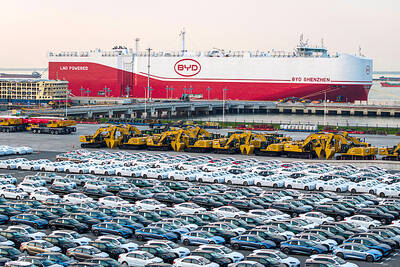China’s exports for last month grew much more strongly than expected, official figures showed yesterday, as a rebound in overseas shipments gained strength on demand from China’s US and Europe.
Exports increased 12.7 percent to US$202.2 billion from November last year, the Chinese General Administration of Customs said — compared with a forecast of 7 percent in a poll of 11 economists by the Wall Street Journal reported by Dow Jones Newswires.
Imports were up 5.3 percent year-on-year to US$168.4 billion, with China’s trade surplus last month expanding to US$33.8 billion from US$31.1 billion in October.

Photo: Reuters
The surplus for last month was also considerably larger than the median forecast of US$21.7 billion by the 11 economists.
The surprisingly strong exports data came after overseas shipments expanded 5.6 percent in October following a decline of 0.3 percent in September.
“China’s November exports came in much higher than expected,” ANZ bank economists Liu Li-Gang (劉利剛) and Zhou Hao (周浩) said in a report, citing “better demand from developed economies” the US and the EU.
The latest trade data came after China’s economy snapped out of a first-half slump, with GDP growth in the third quarter accelerating to 7.8 percent after it slowed during the first two quarters.
Earlier this month, official figures showed that China’s manufacturing growth maintained a strong pace last month from the previous month to stay at a 19-month high.
The purchasing managers’ index (PMI) was at 51.4, unchanged from October, the Chinese National Bureau of Statistics said.
A reading above 50 signals expansion while a figure below indicates contraction.
In the first 11 months of the year, China’s total trade, combining exports and imports, reached US$3.8 trillion, up 7.7 percent from the same period last year, Customs said. The government’s target for this year is 8 percent.
“The data in January to November suggest that China could achieve the 8 percent trade growth target for the whole year,” Liu and Zhou said.
However, they cautioned against overoptimism, stressing what they described as “inflated export growth in the first half of the year” when companies were caught overinvoicing, which instigated a crackdown by Chinese authorities on the practice.
Meanwhile, China, the world’s largest buyer of iron ore, increased imports of the steelmaking ingredient to a record last month as traders replenished stockpiles.
Imports totaled 77.84 million tons last month, up from 67.83 million tonnes in October and 65.78 million tonnes a year earlier, the latest customs data showed.
Cumulative shipments in the first 11 months jumped 10.9 percent to 746.1 million tonnes, the customs agency said.
Iron ore entered a bull market in July as users in China increased stockpiles that shrank in March to the lowest level since 2009.
The market’s supply and demand outlook is positive as producers globally struggle to deliver larger volumes and demand in China continues to grow strongly, Rio Tinto Group iron ore chief executive officer Andrew Harding said on Wednesday.
Additional reporting by Bloomberg

Micron Memory Taiwan Co (台灣美光), a subsidiary of US memorychip maker Micron Technology Inc, has been granted a NT$4.7 billion (US$149.5 million) subsidy under the Ministry of Economic Affairs A+ Corporate Innovation and R&D Enhancement program, the ministry said yesterday. The US memorychip maker’s program aims to back the development of high-performance and high-bandwidth memory chips with a total budget of NT$11.75 billion, the ministry said. Aside from the government funding, Micron is to inject the remaining investment of NT$7.06 billion as the company applied to participate the government’s Global Innovation Partnership Program to deepen technology cooperation, a ministry official told the

Taiwan Semiconductor Manufacturing Co (TSMC, 台積電), the world’s leading advanced chipmaker, officially began volume production of its 2-nanometer chips in the fourth quarter of this year, according to a recent update on the company’s Web site. The low-key announcement confirms that TSMC, the go-to chipmaker for artificial intelligence (AI) hardware providers Nvidia Corp and iPhone maker Apple Inc, met its original roadmap for the next-generation technology. Production is currently centered at Fab 22 in Kaohsiung, utilizing the company’s first-generation nanosheet transistor technology. The new architecture achieves “full-node strides in performance and power consumption,” TSMC said. The company described the 2nm process as

POTENTIAL demand: Tesla’s chance of reclaiming its leadership in EVs seems uncertain, but breakthrough in full self-driving could help boost sales, an analyst said Chinese auto giant BYD Co (比亞迪) is poised to surpass Tesla Inc as the world’s biggest electric vehicle (EV) company in annual sales. The two groups are expected to soon publish their final figures for this year, and based on sales data so far this year, there is almost no chance the US company led by CEO Elon Musk would retain its leadership position. As of the end of last month, BYD, which also produces hybrid vehicles, had sold 2.07 million EVs. Tesla, for its part, had sold 1.22 million by the end of September. Tesla’s September figures included a one-time boost in

Shares in Taiwan closed at a new high yesterday, the first trading day of the new year, as contract chipmaker Taiwan Semiconductor Manufacturing Co (TSMC, 台積電) continued to break records amid an artificial intelligence (AI) boom, dealers said. The TAIEX closed up 386.21 points, or 1.33 percent, at 29,349.81, with turnover totaling NT$648.844 billion (US$20.65 billion). “Judging from a stronger Taiwan dollar against the US dollar, I think foreign institutional investors returned from the holidays and brought funds into the local market,” Concord Securities Co (康和證券) analyst Kerry Huang (黃志祺) said. “Foreign investors just rebuilt their positions with TSMC as their top target,